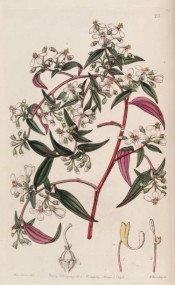Centradenia inaequilateralis G.Don
Tender evergreen sub-shrub with ovate lance-shaped leaves and terminal racemes of rosy-pink flowers. [RHSD].
Horticultural & Botanical History
Introduced to Britain in 1843. [JD]. ‘A pretty greenhouse half shrubby plant, introduced from Mexico by Messrs. Lucombe, Pince, and Co., Nurserymen of Exeter, by whom it was sent in flower to the Horticultural Society in January last. When allowed to blossom quietly in a cool greenhouse it forms a deep green bush, studded all over with gay flesh-coloured stars; but as the petals easily fall, the plant does not bear travelling well. It is a soft-wooded species, growing a foot or so high in sandy peat, and striking readily from cuttings. As far as we can judge from an experience of a few weeks it seems to require a sunny station, but not a dry atmosphere. Mr. Bentham has pointed out its near affinity to the Rhexia inaequilateralis of Schlechtendahl, afterwards called Plagiophyllum by him, and Centradenia by Don. Upon turning, however, to an authentic specimen of that plant, we find it different in some respects: its leaves are much larger and thinner, its flowers appear to be smaller, and are arranged in little terminal racemes much shorter than the leaves. Neither can this be the Plagiophyllum grandifolium of Schlechtendahl, which is described with leaves as much as six inches long. One of the most curious circumstances connected with this plant is the constant abortion, and frequent loss, of one of its two opposite leaves. This tendency to abortion always alternates along the branches, so that if the first imperfect leaf happens to be on the right of the branch, the next is on the left, and so on. The smaller leaves readily fall off, and thus the others appear to be alternate, as is in fact shewn by the artist who prepared the accompanying drawing.’ [BR f.20/1843 as Centradenia rosea].
History at Camden Park
It may have been obtained from the London Horticultural Society or Kew Gardens. It was included among desiderata in a letter to John Lindley dated 15th February 1848 [MP A2933-1, p.157] and to Kew at about the same time [MP A2933-1, p.165] but was not marked ‘arrived’. It was requested again of Kew on 1st February, 1849 [MP A2933-1, p.177] and of Lindley again on 1st February, 1849 [MP A2933-1, p.182a]. There is no direct record of this plant growing in the gardens.
Notes
Published Mar 20, 2009 - 04:59 PM | Last updated Mar 24, 2010 - 02:01 PM
| Family | Melastomataceae |
|---|---|
| Category | |
| Region of origin | Mexico |
| Synonyms |
|
| Common Name | |
| Name in the Camden Park Record | Centradenia rosea |
| Confidence level | high |


